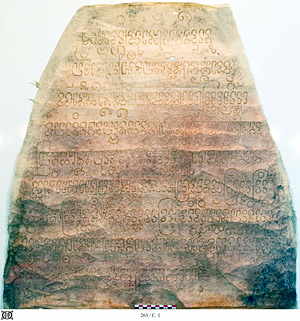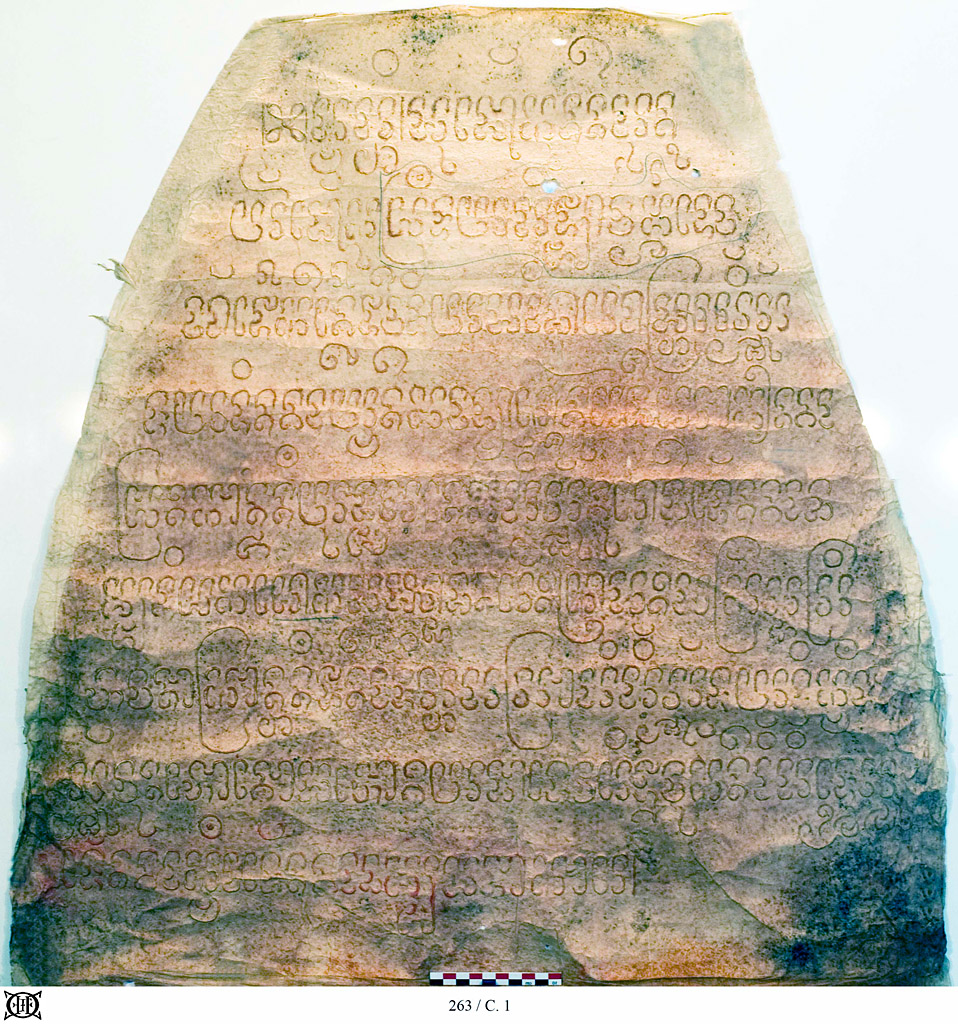Corpus of the Inscriptions of Campā


C. 1 The back of a Viṣṇu Statue at Biên Hòa
Please note: you are reviewing a preprint version of this publication. Contents here may change significantly in future versions. Scholars with specific interests are urged to consult all cited bibliography before using our texts and translations or drawing other significant conclusions.
Support Back of a sculptural stela of Viṣṇu; apparently of sandstone; according to Cabaton 1904: 687, the sculpture itself is maximally 150 cm in height, while the inscribed surface measures h. 85 cm × w. 65. The dimensions we have ourselves recorded (136 × 83 × 40) concern the sculptural stela itself, in its present state of insertion in a large altar, which may explain the discrepancy for height.
Text Nine lines on one face written in Old Cam.
Date 1343 Śaka (1421/2 CE).
Origin Pagoda of Bửu Sơn (Hòa Bình, Biên Hòa, Đồng Nai, Vietnam).
This inscription was found before 1891, when it was first mentioned in the literature (Aymonier 1891: 7 and 84-85). Aymonier noted (p. 7):
It was observed again before 1901, when it was reported, in Finot 1901: 18, thatAux inscriptions que j'ai fait estamper moi-même en 1885 je n'ai pu joindre ici qu'un seul document d'après une copie faite dans le temps par M. Jeanneau, qui en avait remis la photographie au chef des bonzes de Phnom-Penh. Je la tiens de ce dernier. C'est une inscription tchame. M. Jeanneau la croyait khmère et dit qu'elle a été trouvée sur le socle d'une statue à Bien-hoa, dans la Cochinchine française actuelle. Je suppose que la statue en question orne actuellement quelque collection particulière en France. Il serait à désirer que l'inscription pût être estampée, la copie étant insuffisante.
In n. 3, Finot adds: “Nous devons ce dessin, accompagné d'une bonne reproduction de l'épigraphe, à l'obligeance de M. Cabanes de Laprade, administrateur adjoint de l'arrondissement de Biên-hòa.” We observed it still in the same pagoda on 6 September 2013, on which occasion we were able to produce an inked estampage. We were informed that the pre-1975 administrative division of the site were thôn Bình Thành, xã Bình Trứơc, quận Đức Tu, tỉnh Biên Hòa, which have since been drastically altered.La statue a par bonheur échappé aux collectionneurs. Viṣṇu est devenu une idole annamite. Il reçoit un culte dans la pagode de Bưu-sơn, village de Binh-trươc, hameau de Binh-thanh, à environ 800 m N.-O. de l'Inspection de Biên-hòa. La statue, haute de 1m50, est adossée à une stèle, dont la face postérieure porte l'inscription chame dont parle M. Aymonier. Elle a été trouvée près du village, dans le creux d'un gros arbre, et transférée dans la petite pagode actuelle, où il est impossible de la photographier. Nous en donnons (fig. 4) un dessin fait par un indigène et dont l'exactitude a été vérifiée (3).
Edition(s) Partly deciphered on the basis of unsatisfactory documents in Aymonier 1891: 84-85,1 with French translation of the translated parts. Completely edited for the first time in Cabaton 1904; contents summarized in Majumdar 1927: 224, reproduced with minimal modifications in Golzio 2004: 199-200. We have re-edited the text here from the EFEO estampages.
Facsimiles
- Eye-copy published by Cabaton 1904 as fig. 6 on p. 688 in BEFEO 4.2
- Estampage: EFEO 263
- Estampage: EFEO n. 2313
The following text was edited by Arlo Griffiths.
(2) yām̃ pom̃ ku śrī jaya siṅhavarmmadeva
(3) urām̃ ṅauk· glauṅ· vijaya paripāla rāṣtra sim̃ tmum̃
(4) jaya di nagara yvan· ma°udyāṇna gulāc· tok· nagara
(5) braḥ kānda nī yuddha aneka sim̃ tmum̃ gulāc· jem̃ nagara ca-
(6) mpa di śaka loka aṣṭārdhanalaḥ ṇrapaḥ sakram̃tta tri-
(7) bhavanākrānta nī ṅan· ri jitta sa trā si sim̃ tmum̃ jaya di kvīra
(8) tmum̃ vuḥ bhogopabhoga yathādeva liṅga vukam̃n· rim̃ sim̃ jmai tmum̃
(9) jem̃ nagara kvīra jem̃ nagara campa sadākāla |
3 urām̃ ◇ uraṅ Cabaton. — rāṣtra ◇ rāṣṭra Cabaton. — 6 aṣṭārdhanalaḥ ◇ ṣaṣṭārthānalaḥ Cabaton; aṣṭārdhānalaḥ Aymonier; aṣṭārdhanalaḥ Finot. The reading of Aymonier was included in an authorial addition to Cabaton 1904: 690, while Finot took the editorial liberty of inserting his own reading in n. 5 on that same page. Although we do not see a long ā-vocalization on the dg, we agree with Finot and Aymonier that it is necessary to understand aṣṭārdha-analaḥ. — ṇrapaḥ ◇ Finot; ṇdapaḥ Cabaton. The same spelling is found in C. 43, face B, l. 4 and 7. Finot's reading is publised in n. 5 to . — sakram̃tta ◇ pakram̃ttha (?) Cabaton. Cf. C. 43, face A, l. 9 and c, l. 15 and 21; C. 118. — 6-7 tribhavanākrānta ◇ correct tribhuvanākrānta. The same correction is implicit from Cabaton's translation. — 7 ra jitta ◇ vijitta Cabaton. — kvīra ◇ kvīr Cabaton. — 8 vukam̃n· ◇ vukān Cabaton. — 9 kvīra ◇ kvīr Cabaton.
Translations
English
Hail! The P.P.K., son of Y.P.K. Śrī Jaya Siṁhavarmadeva, man of Ṅauk Glauṅ Vijaya, was the protector of the realm. He had obtained victory in the land of the Viet, went out [and] returned to take this land of Braḥ Kānda [through] many battles. He has succeeded to create again (? tmuv gulāc jeṅ) a Campa land in Śaka (3) worlds, half-of-eight (4), (3) fires, (1) king (i.e. in 1343 Śaka). He caused this Tribhuvanākrānta (i.e. Viṣṇu) to be made. And he ... he obtained victory in Cambodia and succeeded to give property and means of existence per deity for various liṅgas. Also: let the Khmer land never succeed in ruling it, but [let] the Campa land [rule it] forever.
French
We cite Cabaton's translation of 1904:
Le fils de Śrī Jaya Siṁhavarman, Ṅauk Glauṅ Vijaya, protège le royaume. Il a vaincu le royaume annamite. Il est parti (en campagne) et est revenu prendre ce nagara Braḥ Kānda. Il a gagné de nombreuses batailles et est revenu au royaume de Champa en (l'année de l'ère) śaka (désignée par) mondes, soixante (ou huit), trois, roseau (ou feu). Il a édifié pieusement ce Tribhuvanākrānta avec le butin qu'il avait conquis sur les Khmèrs. Il a donné comme possession à différents dieux et liṅgas et il s'abstient à jamais d'en jouir, soit dans le nagara khmèr, soit dans le nagara cham.
Commentary
Secondary Bibliography
- Finot 1901: 18 and fig. 4.
- Finot 1915a: 14.
- Parmentier 1909: 553-555 and fig. 127.
- Boisselier 1963: 365 and fig. 235.
Notes
- Aymonier observed: “Le document doit être assez net, mais nous ne le connaissons que par des photographies de copies faites à la main, procédés dont l'exactitude laise trop à désirer”.
- This is not reliable.



Contrary to Cabaton's remark “La date qui, par malheur, est la partie la plus endommagée de l'inscription” (Cabaton 1904: 688), perpetuated by Majumdar and Golzio, the whole of the inscription is very well preserved, or at least it was at the time of Cabaton, when the EFEO estampage was made. The problems that previous scholars felt in interpreting the chronogram were due to inexperience with the peculiarities of the inscriptions of this period, not due to the state of preservation of the inscription.